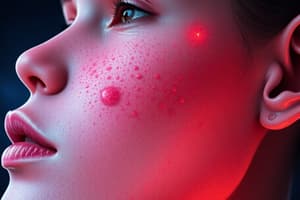Podcast
Questions and Answers
Who first described actinic keratoses in 1826?
Who first described actinic keratoses in 1826?
- Jansen
- Pinkus
- Freudenthal
- Dubreuilh (correct)
What term was later proposed by Freudenthal for actinic keratoses?
What term was later proposed by Freudenthal for actinic keratoses?
- Keratoma senilis (correct)
- Keratoma maligna
- Actinic lesions
- Solar keratosis
According to some authors, how should actinic keratoses be classified due to DNA modifications in keratinocytes?
According to some authors, how should actinic keratoses be classified due to DNA modifications in keratinocytes?
- As benign lesions
- As in situ neoplasms (correct)
- As acute inflammatory lesions
- As benign tumors
What is one of the characteristics of actinic keratoses mentioned in relation to malignancy?
What is one of the characteristics of actinic keratoses mentioned in relation to malignancy?
Which of the following is NOT a synonym for actinic keratoses?
Which of the following is NOT a synonym for actinic keratoses?
What are actinic keratoses primarily characterized by?
What are actinic keratoses primarily characterized by?
Where do actinic keratoses typically occur?
Where do actinic keratoses typically occur?
What factor is the primary cause of actinic keratoses?
What factor is the primary cause of actinic keratoses?
What is the risk associated with untreated actinic keratoses?
What is the risk associated with untreated actinic keratoses?
How can actinic keratoses at initial stages be identified most effectively?
How can actinic keratoses at initial stages be identified most effectively?
What percentage range reflects the prevalence of actinic keratoses in Caucasian individuals above 40 years?
What percentage range reflects the prevalence of actinic keratoses in Caucasian individuals above 40 years?
Which therapeutic modality is NOT commonly used for actinic keratoses?
Which therapeutic modality is NOT commonly used for actinic keratoses?
In the diagnosis of actinic keratoses, what may sometimes be necessary besides clinical examination?
In the diagnosis of actinic keratoses, what may sometimes be necessary besides clinical examination?
What common dermatological diagnosis represents the fourth most frequent in Brazil?
What common dermatological diagnosis represents the fourth most frequent in Brazil?
What molecular alteration is commonly associated with both actinic keratoses and spinocellular carcinomas?
What molecular alteration is commonly associated with both actinic keratoses and spinocellular carcinomas?
At what age group do actinic keratoses represent the main reason for dermatological consultation in Brazil?
At what age group do actinic keratoses represent the main reason for dermatological consultation in Brazil?
In the study conducted in Curitiba, what was the prevalence of actinic keratosis in women?
In the study conducted in Curitiba, what was the prevalence of actinic keratosis in women?
What is the prevalence of actinic keratoses among individuals in Northern Brazil as mentioned in the study?
What is the prevalence of actinic keratoses among individuals in Northern Brazil as mentioned in the study?
Which term has been proposed as a replacement for actinic keratosis?
Which term has been proposed as a replacement for actinic keratosis?
What percentage of actinic keratosis prevalence was observed in Japanese descendants living in Bauru?
What percentage of actinic keratosis prevalence was observed in Japanese descendants living in Bauru?
The study indicates that actinic keratosis prevalence increases with which patient characteristic?
The study indicates that actinic keratosis prevalence increases with which patient characteristic?
Flashcards are hidden until you start studying
Study Notes
Actinic Keratoses Overview
- Actinic keratoses (AK) are dysplastic proliferations of keratinocytes with a potential for malignant transformation.
- Clinically manifest as macules, papules, or hyperkeratotic plaques often on sun-exposed areas with an erythematous background.
- Initial identification may require palpation, as lesions can be subtle in early stages.
- Possible pigmentation and variable infiltration; multiple lesions signify field cancerization.
- Prevalence among Caucasians over 40 years ranges from 11% to 60%.
Pathogenesis and Risk Factors
- Primary risk factor is ultraviolet (UV) radiation exposure; individual genetic factors also contribute.
- Diagnosis often involves both clinical evaluation and dermoscopy; histopathological analysis may be necessary in certain cases.
- Major concern is the transformation risk into squamous cell carcinoma (SCC).
Treatment Options
- Therapeutic approaches include topical medications, ablative therapies, and surgical options.
- Treatment must be individualized based on patient factors.
Historical Context
- The condition was first described by Dubreuilh in 1826, with subsequent nomenclature changes reflecting evolving understanding.
- Currently considered pre-neoplastic; some authors propose viewing them as in situ neoplasms due to clonal DNA modifications.
Epidemiology in Brazil
- Actinic keratoses are the fourth most common dermatological diagnosis in Brazil.
- Represent the leading reason for dermatological consultations in individuals over 65 years (17.2%).
- In Southern Brazil, constitute 7.4% of diagnoses, lower in the North region at 2.89%.
- A study in Curitiba reports a 60.79% prevalence rate in women and 30.9% in men, with a mean age of 59.8 years.
- High prevalence noted among Brazilian Japanese descendants with a rate of 13.4%, mean age of 68.9 years, surpassing similar demographic studies in Japan.
Cellular and Molecular Characteristics
- Histological features include loss of polarity, nuclear pleomorphism, disorganized maturation, and increased mitotic activity.
- Similar p53 mutations found in keratinocytes of AK and SCC, reinforcing the potential malignancy of AK.
Evolutionary Perspective
- No clear threshold exists between actinic keratoses and thin SCC; considered part of the evolutionary spectrum of SCC.
- Proposed alternative names reflect the developmental connection between AK and early-stage squamous cell carcinoma.
Studying That Suits You
Use AI to generate personalized quizzes and flashcards to suit your learning preferences.




